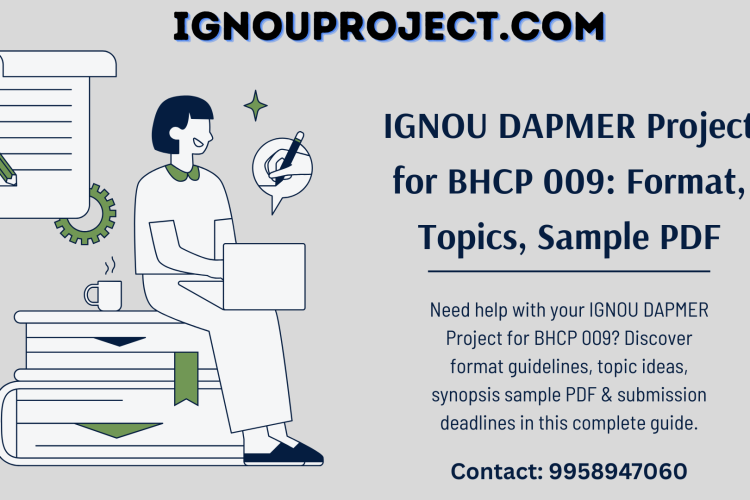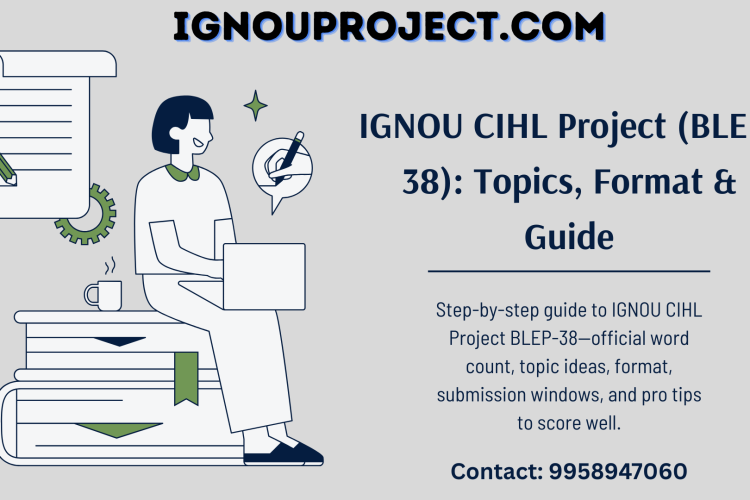
Introduction of IGNOU BAJDM Project
An IGNOU BAJDM Project work stands for the course Bachelor of Arts in Journalism and Digital Media helps students combine digital media skills and apply them to other communication areas. This program is suitable for practicing journalists who want to improve their skills and knowledge. A Bachelor of Journalism program provides hands-on training in journalism, digital communication, multimedia storytelling, and converging media.
Whatsapp us to get the Personalized (Customized) IGNOU BAJDM Project Report and Synopsis
Download PDF Link for IGNOU BAJDM Project for BNMP 021/022
This IGNOU BAJDM Project (BNMP 021/022) has a strong professional focus, with an emphasis on practical learning. Digital media has witnessed double-digit growth in the last five years, and it is likely to continue this growth trend for a couple of decades. This growth indicates the growing demands for professionals in digital media, online platforms, internet technology and communication technology. The massive expansion of IT and communication infrastructure over the past two decades resulted in significant growth in areas such as revolutionising information transmission, distribution, and information consumption behaviour. As a result, citizens have developed a desire to access information from every possible source, furthering their socio-economic, political, and development-oriented initiatives and paving the way for the growth and development of journalism and mass communication as a profession.
What is the submission process for the BAJDM project?
The submission process for the IGNOU BAJDM project involves several steps, which may vary slightly depending on the specific guidelines provided by IGNOU at the time you are undertaking your project.
Step 1: Preparation
- Finalize Your Project: Ensure your project work is complete, including research, analysis, and any practical components.
- Write Your Project Report: Following the prescribed format and guidelines (such as font size, type, margin, spacing, and structure), compile your findings and analyses into a comprehensive project report. This report typically includes an introduction, literature review, methodology, findings, discussion, conclusions, and recommendations.
Step 2: Review and Approval
- Internal Review: Before submission, it’s a good idea to have your academic mentor or supervisor review your project. They can provide valuable feedback and suggest improvements.
- Approval (if required): Some programs may require you to get formal approval for your project or proposal before the final submission. This step might involve submitting a synopsis or proposal through an online portal or directly to your supervisor or regional center for approval.
Step 3: Submission
- Follow the Latest Guidelines: Check the IGNOU website or contact your regional center for the most up-to-date submission process, as it can vary. There may be an online submission portal or specific offline submission procedures to follow.
- Online Submission: If the submission is online, you’ll most likely need to upload your project report as a PDF or in the format that the university specifies. Ensure your document is named correctly and follows any specified naming conventions.
- Offline Submission: If you’re required to submit your project report in hard copy, make sure to print it according to the formatting guidelines and bind it if required. You will then submit it to the designated office or regional center by the deadline.
Step 4: Confirmation and Follow-up
- Submission Confirmation: If you submit your project online, ensure you receive a submission confirmation or receipt. For offline submissions, keep a copy of the submission receipt or acknowledgment.
- Check for Updates: After submission, stay in touch with your study center or the online portal for any updates regarding your project evaluation, feedback, or results.
Important Tips
- Adhere to Deadlines: Be aware of the submission deadlines and plan to submit your project well in advance to avoid any last-minute issues.
- Documentation: Keep copies of all submissions and correspondence regarding your project. This documentation can be crucial in case of any discrepancies or queries from the university.
- Feedback and Resubmission: In case there are issues with your submission or your project is not accepted in its current form, carefully review the feedback, make necessary adjustments, and resubmit as per the given instructions.
How long should the BNMP 021/022 project report be?
The length of the project report can vary depending on the specific requirements outlined by IGNOU. However, it typically ranges from 10,000 to 15,000 words. It’s important to consult the latest guidelines provided by IGNOU for your batch as these requirements may change.
What will happen if your IGNOU BAJDM project is rejected?
If your project is rejected, you will receive feedback on the areas that need improvement. You will have the opportunity to revise your work and resubmit it. It’s crucial to closely follow the feedback and make the necessary adjustments to meet the project criteria.
For the most current information and specific details regarding the IGNOU BAJDM project, please refer to the official IGNOU website or contact your study center. Guidelines and requirements may be updated, so it’s important to refer to the latest documents provided by the university.
Choosing a good topic for your IGNOU BAJDM project
Choosing a topic for your IGNOU BAJDM project (BNMP 021/022) is a crucial step that requires thoughtful consideration. Your project topic should reflect not only your personal interests and career aspirations but also align with academic guidelines and be feasible in terms of research and analysis. Here are some steps and tips to help you select an appropriate topic:
1. Explore your interests
Consider areas within journalism and Digital Media that genuinely interest you. This could be anything from digital media, print journalism, public relations, advertising, to specific issues like media ethics, the role of media in society, or the impact of social media on news consumption. Reflect on your coursework and identify topics that sparked your curiosity or where you excelled.
2. Identify a gap or question
Look for gaps in the existing literature or areas where you have questions. Your project could aim to fill these gaps or provide insights into unresolved questions. Conduct a preliminary review of recent research articles, news articles, and textbooks to understand current trends and debates in the field.
3. Consider the scope
The topic should be neither too broad nor too narrow. A broad topic might be challenging to manage within the constraints of your project, while a very narrow topic might not have enough material for research. Ensure the scope of your project is manageable, considering the time and resources available to you.
4. Feasibility
Think about the practical aspects of your research. Do you have access to the necessary resources, such as participants for interviews, relevant databases, or case studies? Consider the research methods you will use and ensure they are feasible. For instance, will you conduct surveys, interviews, content analysis, or use another method?
5. Consult with Your Supervisor
Discuss your ideas with your academic supervisor or mentor. They can provide valuable feedback, suggest potential resources, and help refine your topic to ensure it meets academic standards and criteria. Your supervisor’s experience and knowledge can guide you in choosing a topic that is both interesting and achievable.
6. Relevance
Ensure your topic is relevant to the field of journalism and Digital Media. It should contribute to the existing body of knowledge and be of interest to scholars, practitioners, or both. Consider the implications of your research. How might it benefit the field, influence practice, or inform policy?
7. Originality
While it’s challenging to find a completely untouched topic, aim for originality in your approach or perspective. Your project should add something new or offer a fresh take on existing debates or issues.
8. Review past projects
If possible, review past projects submitted by students in your program. This can give you an idea of what has been done and what might still be explored.
FAQs (Frequently Asked Questions) for IGNOU BAJDM Project (BNMP 021/022)
1. How do I choose a topic for my BAJDM project?
Answer: Choose a topic that interests you and aligns with your career goals. It should be relevant to the field of journalism and Digital Media, feasible in terms of research and resources, and contribute new insights or perspectives to the subject area. Consult with your project supervisor for guidance and approval before finalizing your topic.
2. What is the format and structure of the BAJDM project report?
Answer: The report typically follows a structured format, including:
- Title page
- Declaration
- Certificate
- Acknowledgment
- Table of contents
- Introduction (including objectives and scope of the study)
- Literature review
- Methodology
- Data analysis and findings
- Conclusion and recommendations
- References/bibliography
- Appendices (if any)
- Adhere to the specific guidelines provided by IGNOU regarding formatting, word count, and citation style.
3. Can I work in a group for my project?
Answer: IGNOU projects are usually individual efforts to assess each student’s understanding, research ability, and creativity. However, it’s essential to confirm this with your department or project guide, as guidelines may vary.
4. How do I find a supervisor for my project?
Answer: IGNOU usually assigns a supervisor or mentor to guide you through your project. If you need to find one independently, choose a faculty member who has expertise in your chosen topic area. Ensure you communicate regularly with your supervisor for advice and feedback throughout the project.
Ready to get your IGNOU BAJDM Project Report and Synopsis Sample PDF for BNMP 021/022?
- Call us or WhatsApp us at: 9958947060, 9354637830
- Visit: IGNOUPROJECT.COM

